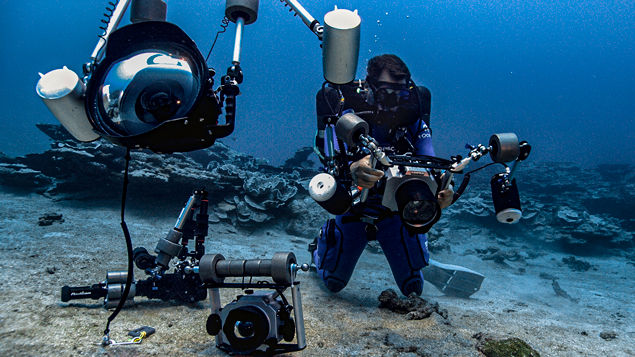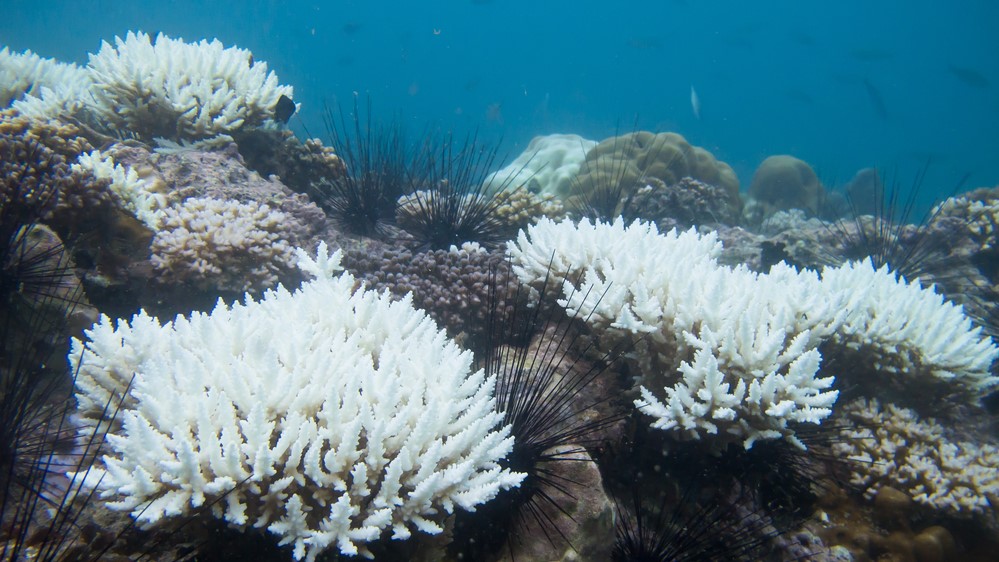Massive 'pristine' reef of giant rose-shaped corals discovered lurking unusually deep off the coast of Tahiti
One diver described the stunning reef as "a work of art."
Scuba divers with the United Nations Educational, Scientific and Cultural Organization (UNESCO) have discovered and mapped out a massive reef of giant rose-shaped corals hidden off the coast of Tahiti, the largest island in French Polynesia in the South Pacific. The structure is in "pristine" condition and has remained surprisingly healthy despite recent coral bleaching events in the region.
The newly discovered coral reef, which remains unnamed, is around 1.9 miles (3 kilometers) long and between 98 and 213 feet (30 to 65 meters) across. It lies between 100 and 180 feet (31 to 55 m) below the surface, which is unusually deep for a tropical coral reef and may have shielded it from climate change effects. The reef is made up predominantly of Pachyseris speciosa, an encrusting plate-like coral that forms rose-shaped colonies that can grow to be 6.5 feet (2 m) wide, according to the World Register of Marine Species.
Divers from the seafloor exploration project Ocean 1 first discovered the reef in November 2021. "It was magical to witness giant, beautiful rose corals which stretch for as far as the eye can see," Alexis Rosenfeld, an underwater photographer and founder of the Ocean project, which is jointly run by UNESCO, said in a statement. "It was like a work of art."
Related: 10 signs that Earth's climate is off the rails
Unusually deep
A majority of coral reefs in tropical regions like Tahiti are found in shallow water above 82 feet (25 m) deep. The newly discovered reef is located toward the upper limit of the mesophotic zone, which stretches from 100 feet (30.5 m) below the surface to over 490 feet (149 m) below the surface, according to the National Oceanic and Atmospheric Administration (NOAA).
Corals in the mesophotic zone receive less light than their counterparts in shallow-water coral reefs. To make up for this lack of light, corals like P. speciosa are wide and flat to maximize their light-collecting surface area.
The location of the new reef at the upper limit of the mesophotic zone has historically been very hard for scientists to study because it is too deep for traditional scuba diving and too shallow to use remotely operated vehicles (ROVs), according to NOAA. However, divers have developed new technology, such as the use of air containing helium, which negates hallucinations caused by oxygen and nitrogen at depth and helps prevent the bends, or decompression sickness that make it easier to explore these deep regions for longer periods. Combined with better underwater camera equipment, this new technology has made the mesophotic zone fully explorable for the first time, according to the statement
Get the world’s most fascinating discoveries delivered straight to your inbox.
The team from 1 Ocean took advantage of these technological advancements and carried out dives on the reef totaling around 200 hours, which allowed them to map it in great detail and even witness the spawning of corals, according to the statement.
Protected from harm
Coral reefs are one of the most at risk ecosystems on Earth. In total, 237 coral species are currently listed as threatened by extinction on the International Union for the Conservation of Nature (IUCN) Red List, according to Our World in Data.
Corals face threats from plastic and chemical pollution, overfishing, sediment run-off, ecotourism and explosive fishing with dynamite. However, the main issue facing coral reefs is the increase in atmospheric greenhouse gases, which raises sea-surface temperatures and acidifies the ocean. This combo can cause coral bleaching, where corals expel the photosynthetic algae that live inside their tissue and provide them with energy. This bleaching process not only drains corals of their color, it is often fatal to coral colonies.
Between 2014 and 2017, more than 75% of global coral reefs experienced some degree of coral bleaching due to an El Niñoevent, which is a natural phenomenon that increases sea-surface temperatures in the Pacific that was exacerbated by climate change, according to NOAA. However, mesophotic reefs may have escaped relatively unscathed due to their cooler temperatures.
"We think that deeper reefs may be better protected from global warming," Laetitia Hedouin, a coral expert at the French National Center for Scientific Research, who was involved with the project, said in the statement. For example, the new reef was unscathed by a major bleaching event that struck French Polynesia in 2019.
So mesophotic reefs could become vital backups to decimated shallow-water reefs and provide a new home for displaced species such as fish and crustaceans, according to NOAA. "The discovery of this reef in such a pristine condition is good news and can inspire future conservation," Hedouin said in the statement.
Originally published on Live Science.

Harry is a U.K.-based senior staff writer at Live Science. He studied marine biology at the University of Exeter before training to become a journalist. He covers a wide range of topics including space exploration, planetary science, space weather, climate change, animal behavior and paleontology. His recent work on the solar maximum won "best space submission" at the 2024 Aerospace Media Awards and was shortlisted in the "top scoop" category at the NCTJ Awards for Excellence in 2023. He also writes Live Science's weekly Earth from space series.





